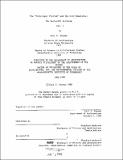| dc.contributor.advisor | GRSN 539825 | en_US |
| dc.contributor.author | Fenske, Gail | en_US |
| dc.coverage.spatial | n-us-ny | en_US |
| dc.date.accessioned | 2005-08-10T19:14:44Z | |
| dc.date.available | 2005-08-10T19:14:44Z | |
| dc.date.copyright | 1988 | en_US |
| dc.date.issued | 1988 | en_US |
| dc.identifier.uri | http://hdl.handle.net/1721.1/14037 | |
| dc.description | Thesis (Ph. D.)--Massachusetts Institute of Technology, Dept. of Architecture, 1988. | en_US |
| dc.description | Includes bibliographical references. | en_US |
| dc.description.abstract | The "skyscraper problem" challenged the thought and practice of civic designers and architects prior to World War I. It referred to the incompatibility of City Beautiful principles with economically propelled land development, and to the contradiction between the notion of architecture as an art and the skyscraper's programmatic and technical requirements. Civic designers in New York had difficulty accommodating the skyscraper in their large-scale plans. They also found that it intruded on their vision for the business street, hindered their attempts to plan City Hall Park as New York's civic center, and created a chaotic skyline. Bruce Price, Louis Sullivan, Thomas Hastings, Cyrus L.W. Eidlitz, and other architects suggested alternative proposals for subjecting the skyscraper to the constraints of design . Prior to the design of the Woolworth Building, however, architectural critics did not unanimously endorse any single approach. Frank Woolworth chose a site for his proposed headquarters at the intersection of City Hall Park, New York's civic center, with lower Broadway, the spine of its business district . Woolworth commissioned Cass Gilbert to design the Woolworth Building in 1910. Gilbert shared the City Beautiful vision of McKim, Mead & White and Daniel Burnham. He also accepted the skyscraper's pragmatic requirements. Woolworth intended his headquarters to function as a speculative office building, but also to look like a civic institution. The imagery of a civic institution would represent the capitol of his commercial "empire" as well as display his civic-mindedness, wealth, and cosmopolitanism. The Woolworth Building's siting at New York's civic center, its composition, its arcade, and its sculptural and mural decoration identified it with the prevailing concept of the civic building. The soaring vertical piers of its exterior recalled Gilbert's earlier design for the West Street Building, which was influenced by the functionalist ideas of Louis Sullivan. The Woolworth Building convinced critics that a suitable architectural expression could be found for the skyscraper. Zoning reformers regarded it as a benign skyscraper. Contemporary observers attuned to City Beautiful aesthetic principles thought that the Woolworth Building strengthened the order and image of New York's civic center and enhanced the view of the city from afar. | en_US |
| dc.description.statementofresponsibility | by Gail Fenske. | en_US |
| dc.format.extent | 2 v. (xv, 569 leaves) | en_US |
| dc.format.extent | 95590169 bytes | |
| dc.format.extent | 95589926 bytes | |
| dc.format.mimetype | application/pdf | |
| dc.format.mimetype | application/pdf | |
| dc.language.iso | eng | en_US |
| dc.publisher | Massachusetts Institute of Technology | en_US |
| dc.rights | M.I.T. theses are protected by copyright. They may be viewed from this source for any purpose, but reproduction or distribution in any format is prohibited without written permission. See provided URL for inquiries about permission. | en_US |
| dc.rights.uri | http://dspace.mit.edu/handle/1721.1/7582 | |
| dc.subject | Architecture | en_US |
| dc.subject.lcsh | Skyscrapers New York (State) New York | en_US |
| dc.subject.lcsh | Towers New York (State) New York. | en_US |
| dc.subject.lcsh | Woolworth Building (New York, N.Y.) | en_US |
| dc.title | The "Skyscraper problem" and the city beautiful : the Woolworth Building | en_US |
| dc.type | Thesis | en_US |
| dc.description.degree | Ph.D. | en_US |
| dc.contributor.department | Massachusetts Institute of Technology. Department of Architecture | |
| dc.identifier.oclc | 23271080 | en_US |
